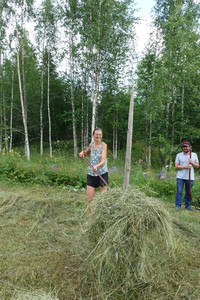Haymaking - tradition and efficiency
- Patrick Vogel

- Jul 20
- 4 min read
Hay harvesting has accompanied farmers for generations and was once characterized by a lot of manual labor, fear of the weather, and strenuous teamwork in the fields. Today, the process has changed dramatically: modern technology and precise planning make harvesting more efficient. But what has been lost, and what has been gained? In this article, we would like to show you how we approach hay harvesting, combining tradition and modern technology.

From community to machines
In earlier times, a farming family often consisted of at least three generations sharing the house and farm, often with many helping hands. This was the only way the laborious manual labor could be completed promptly and efficiently.
Today, a farm typically employs only two or maybe three people, often cheap laborers or apprentices. The area has increased dramatically, and work is performed using large machines that, while heavy, are extremely efficient. Unfortunately, this is detrimental to biodiversity and diversity. Modern mowers give insects no chance to escape, and increasingly heavy harvesters are increasingly compacting the soil.
The cut: Gentle with the motor mower
At Omavaraniemi, we manage approximately 3 hectares of meadows and pastures. During good summers with long periods of good weather, we try to produce as much high-quality hay as possible, so as not to be under pressure in rainy years. We always seek a balance between tradition and efficiency.
Since working with a scythe and pitchfork would be too time-consuming, we cut the grass with a motor mower with a double-blade mower. This allows for a gentle cut: animals have a chance to escape, and the lightweight mower puts minimal strain on the soil. We use another attachment to swath the grass. This means we pile it up into small rows. This keeps most of the grass off the often damp ground, dries faster, and is less likely to mold. Depending on the weather, we turn the swaths once or twice a day until the hay is dry enough to store.
The Harvest: Three Ways, Three Philosophies
During harvest, we regularly face a small dilemma: On the one hand, we want to protect the soil and avoid heavy machinery as much as possible. On the other hand, it's important to bring in the hay quickly, especially when periods of good weather are short. Furthermore, we have limited storage space, which is why compressed bales are often the better solution.
Depending on the weather, the condition of the meadow and available helpers, we have three different methods for harvesting the hay:
Traditional
The traditional Finnish method is called Heinäseiväs – hay piles or "hay men." For this, we hammer a hole in the ground with an iron rod and place a post about 2.5 meters long into it. This post has three holes at different levels, into which we insert crosspieces. The hay is stacked from bottom to top on these "arms."
This creates an air cushion between the layers, allowing the wind to dry the hay. Thanks to the special layering, rain runs off the outer stalks, while the inner area remains dry. The Heinäseiväs remain in the field for about a week before the hay is placed in the haystack.
We build Heinäseiväs especially during rainy summers or when we simply don't have time to dry them completely. We often do them together with guests, because a field full of Heinäseiväs is not only useful but also looks beautiful.
Classic
When the weather is stable, we bring the dried hay loose on a trailer to the hayloft. This is the most strenuous and time-consuming method, as our trailer isn't very large and we frequently have to travel back and forth between the field and the storage area. Each trailer is packed to the brim. For this method, we need a long and stable period of good weather; the haymaking process alone can take several days.
Efficient and modern
Harvesting is most efficient with a small baler. Fortunately, we have a "neighbor" who owns such a machine. This year, we asked him for help and were amazed at how quickly everything went. Within two hours, we had cleared around 320 bales from the field. This area has never been cleared so quickly. A huge relief.
The bales are compact, easy to store, and, in suitable weather, of excellent quality. However, we don't want to rely solely on this method. The machine is a bit older and could break down at any time. Besides, its owners have their own jobs and can't spontaneously step in when we need them.
Our conclusion
Our haymaking oscillates between the past and the present. We try to combine the best of both worlds, with great respect for nature, the soil, the animals, and also for our own strengths. Because haymaking isn't just work. It's part of a rhythm of life that has changed over the years, but should never be completely lost.
And no matter which method we ultimately choose, when the hay is finally in, a huge weight is lifted from our shoulders. Everyone involved in farming probably knows this feeling. And even if the weather is perfect and the technology is running smoothly:
We'll still build a few Heinäseiväs for the heart, simply because they belong there.





















Comments